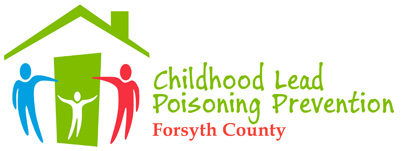 Over 4 million households in the United States have children
that may be exposed to lead, according to the latest information from the Centers
for Disease Control. Lead exposure can affect nearly every system in the body and,
because it has no obvious symptoms, it goes undiagnosed.
Over 4 million households in the United States have children
that may be exposed to lead, according to the latest information from the Centers
for Disease Control. Lead exposure can affect nearly every system in the body and,
because it has no obvious symptoms, it goes undiagnosed.
The Forsyth County Board of Health Childhood Lead Poisoning Prevention Rules recommend that all children be tested for lead at the age of 1 and again at the age of 2 during a well child visit (routine check-up) or at least once before the age of 6, regardless of the age of your home.
Where is lead found?
The most common place lead is found is lead-based paint. Chipping or peeling paint that contains lead and lead contaminated dust are the main sources of lead poisoning. Houses and apartments built before 1978 may have lead-based paint on the inside, outside, or both. Lead-based paint can also be found on toys, furniture, playground equipment, older cars and boats. Soil, especially around the foundation of homes and near highways, and old water pipes may also contain lead. Hobbies such as making pottery, stained glass or refinishing furniture can expose someone to lead. Your occupation can also put you at risk for being exposed to lead (learn more). Lead can also be found in:
- Food that is stored, baked, or served in glazed pottery or ceramics that contain lead English Version Spanish Version
- Fishing weights
- Computer and phone cords, surge protector cords
- Stained glass, brass, pewter and copper
- Occupations such as painting, demolition, smelting or battery manufacturing
- Traditional home remedies that contain Azarcon, Paylooah, and Greta
- Imported Candy
- Traditional ceremonial make-up that contains Kohl, Kumkum, Sindur or Sindoor
- Imported Food and Spices - English Version Spanish Version
Who is at Risk?
Everyone, especially children under the age of 6 and pregnant women, is at risk for lead poisoning. Lead can enter the body by breathing lead contaminated dust (inhale) or by hand to mouth activities (ingest). The developing bodies and brains of young children are at risk because they put their fingers and other items in their mouths that may be contaminated with lead dust. If pregnant women have lead in their blood stream, they can pass it to their unborn children.
Children living at or below the poverty line are most at risk due to poor housing conditions and inadequate diet.
What are the health effects of exposure to lead?
Low levels of lead in the body can damage the nervous system and brain, causing behavior and learning problems such as lowered IQ, hyperactivity, hearing problems and slowed growth. Behavior problems can include irritability or aggressiveness, hyperactivity, learning difficulties and problems concentrating. Extremely high levels of lead in the body can cause seizures, unconsciousness, brain and kidney damage and DEATH in some cases. Adults exposed to lead, from occupations or hobbies, can have high blood pressure, nervous disorders, muscle and joint pain, digestive and reproductive problems and pregnancy complications.
What are the symptoms of lead poisoning?
Most children with lead poisoning do not show any symptoms. When lead poisoning levels are severe, some general symptoms can include digestive problems, fatigue, headaches, and a higher rate of tooth decay. Children with lead poisoning over a long period of time may show lower intelligence and may be smaller in size than children their own age who do not have lead poisoning. A diet rich in Calcium, Iron and Vitamin C and D can reduce the amount of lead in your child’s body. English Version/Spanish Version
What if I am pregnant?
Unborn babies are also affected by lead. Research has shown that lead exposure to a pregnant woman can increase the risk of:
- Premature birth
- Small size and low birth weight
- Miscarriage or stillbirth
- Learning and behavior problems
If you are pregnant or may become pregnant, you should ask your doctor for a blood test for lead. The Centers for Disease Control and Prevention published “Guidelines for the Identification and Management of Lead Poisoning in Pregnant and Lactating Women” for medical providers to follow.
How do I find out if there is lead in my home?
The Environmental Health Division will offer to do an environmental lead investigation to try and find the source(s) of lead in your home IF your child has two blood lead levels of 5-7µg/dL. An environmental lead investigation is required if your child has two blood lead levels of 8µg/dL or greater.
If you do not have a child with an elevated blood lead level, an environmental lead investigation can only be done by a private certified risk assessor or lead paint inspector, for a fee.












